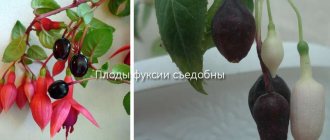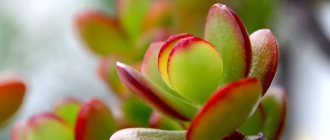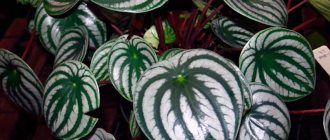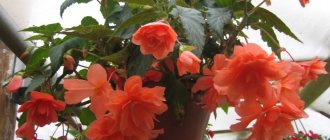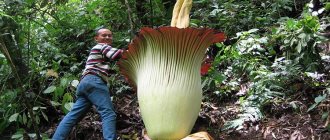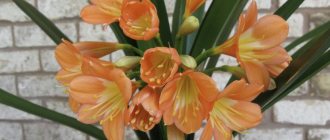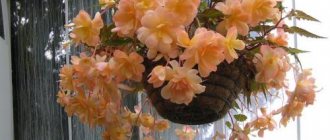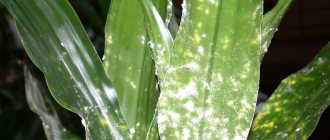General description of clivia
The leaves are herbaceous with a thickened base, collected in a rosette. The flowers are red, yellow or orange, arranged several times in large inflorescences. They bloom twice a year. The first flowering is in February or the first ten days of March, the second in late May-early June. The roots are thick and strong, capable of accumulating moisture and nutrients.
The plant is considered unpretentious; it can be placed on any windows in the house. Of all the varieties, Clivia miniata and Clivia nobilis are cultivated. The first is used medicinally by the Zulu as an antidote for snake bites and a remedy for fever. At the same time, experts warn that the roots of the flower are toxic due to the presence of alkaloids, so they must be used in treatment with caution.
Clivia flowering
A week passes from the opening of the first bud to mass flowering, and the flowers delight with bright colors and a light aroma for more than three weeks.
- At this time, you can not only move the flower pot to another place, but also turn it around: this can lead to the cessation of flowering of the indoor plant.
- After flowering, the flower stalks are completely cut off.
- With proper care, Clívia can bloom twice: in February-March and in September-November.
Types of clivia
Five species of clivia are found in the wild; several more have been bred from them through selection:
- Clivia miniata (cinnabar) is the most common variety; one pedicel can contain from 15 to 20 orange-red inflorescences; peak flowering is February - March.
- White - leaves are fleshy, belt-type, white bell-shaped flowers are collected in inflorescences of 20 pieces. Blooms in early spring.
- Yellow - on an elongated peduncle there are several yellow umbrella flowers, belt-shaped leaf plates, the peduncle opens in mid-spring.
All three species reach a height of 70 cm. In addition to these crops, there are also the following varieties
| Type, description | Inflorescences | Leaves | Flowering time |
| Noble - bred in the Old World back in 1828. Plant length - 30 cm. | On a half-meter peduncle there are up to 60 tubular-dropping orange inflorescences. | Ensiform dark green. | Second half of February. |
| Nobilis (nobilis) is the birthplace of the plant in the Cape Province of the Republic of South Africa. | The flower stem is thick and elastic, with several umbellate flowers of pale red color ripening at the end. | Long, rich green in color with a tapered end. | Second half of winter. |
| Gardena (gardenii) - opened in 1856 by Robert Garden. Plant height up to 50 cm. | Red-orange bell buds. | Ensiform, length varies from 40 to 90 cm. | Late autumn - early winter |
| Beautiful. | 50-60 tubular inflorescences of orange color. | The length of the crop is 30 cm. | Mid-January - early February. |
| Citrina - developed at the beginning of the 19th century. The height of the crop is 60 cm. | Delicate creamy. | Bright green, belt-shaped. | From February to March. |
| Steblevaya - year of opening 1943. | Red-orange, bell-shaped. | It forms a stem from the lower drying leaf plates, from which aerial roots appear. | Spring and summer, less often autumn. |
| Amazing - discovered in 2002. | Drooping bell-shaped inflorescences of coral-orange color. | The base is burgundy and has a white stripe down the middle. | Winter. |
| Variegated. | Blooming bells of ocher color. | Smooth belt-shaped ones are painted with a white stripe in the middle. | May June. |
| Powerful. The height reaches 2 m. | Bell flowers are collected in an umbrella brush. | Long, sword-shaped. | January. |
Characteristics of clivia
The most common variety in home floriculture is Clivia cinnabar.
- Although it belongs to the Amaryllis family, it produces rhizomes instead of the bulbs characteristic of the family.
- The flower has no stem: evergreen leaves grow on top of each other, resembling a fan. The number and size of foliage depend on age: a 14-year-old has up to 24, length - up to 70 cm, width - up to 7 cm.
- An inflorescence with a diameter of up to 20 cm on a high peduncle (up to 30 cm) can consist of 12-26 flowers (deep orange with a yellowish base with a diameter of up to 8 cm), each with six petals arranged in two rows.
- 40 years is the age of a long-lived clivia, subject to all the nuances of cultivation.
Caring for clivia at home - table by season
In order to grow a healthy and beautiful plant, you should consider the following.
| Season | Summer | Rest period | Emergence of flower stem |
| Temperature regime. | +20…+25 °C. | +12…+15 °С | .+20…+25 °C. |
| Lighting. | Natural, outdoors in partial shade. | Place on a windowsill in a northern position, shade it. | Move to western or eastern windows, maximum lighting, but direct sunlight should be avoided. |
| Watering. | Slightly, as moisture evaporates. | From once a week to once a month. | Slightly, as moisture evaporates. |
| Feeding. | Once every 14 days. | They don't. | Once every two weeks. |
| Humidity. | It doesn’t matter, the leaves are washed as the surface becomes dusty. | ||
Why doesn't it bloom
The lack of buds on home clivia can occur for various reasons.
Natural factors
If in the first year of its life the clivia bloomed profusely, then for the next few years it may not bloom at all, since the young flower will be exhausted after flowering, and over the course of several years it will need to gain strength. For this reason, flower growers advise removing the peduncle from young plants.
To stimulate the growth and flowering of clivia, sometimes gardeners resort to creating artificial stressful situations: they place the plant in a dark room for several days.
Improper care
Clivia may not bloom if:
- lack of light;
- lack of winter dormancy;
- watering with cold water;
- air temperature is not warm enough.
Irrigation regime violations
If watering is not correct, clivia may not bloom for a long time. Therefore, watering should be moderate and regular (especially in the summer). The main thing is that the top layer of soil dries well between waterings. At the beginning of spring, watering is gradually reduced, and in winter, the plant is practically not watered.
If the plant has thrown out a flower arrow, but has stopped growing, it is watered with warm water (about 40 degrees).
Incorrect application of fertilizers
Improper application of fertilizers also negatively affects the flowering of clivia. Frequent feeding promotes abundant growth of leaves and root system, to the detriment of abundant flowering. Fertilize the plant at the moment the buds open once every two weeks. Before the dormant period (early August), fertilization is stopped.
Watering and fertilizing
On warm days, clivia requires regular watering. During the dormant period, it is practically not carried out or the soil is moistened extremely rarely. During flowering, abundant irrigation with water at room temperature is recommended.
Organic and mineral supplements are required for the crop in a proportion of 2 g per 2 liters of water and only during flowering. Fertilizing is indicated once every six months. They also give a minimum amount of nitrogen fertilizers, since they slow down flowering and, conversely, cause increased leaf growth.
Clivia pests
An indoor flower may be attacked by certain types of insects.
Shields
They are frequent pests of clivia, as evidenced by the appearance of plaques on the leaves and stems of the flower. The pest sucks out the sap of the plant, and as a result, the leaves lose color, wither and fall off.
You can get rid of scale insects mechanically: you need to wipe the leaves with a sponge moistened with laundry soap. Afterwards, the culture needs to be treated with Actellik - for this you need to dilute 1.5 g of the drug in 1 liter of water.
Mealybug or feltworm
If you notice that the leaves of a flower have begun to deform and dry out, it means that it has been affected by feltworm. Because of this pest, the plant may die.
You can defeat mealybugs using a soapy sponge. You need to wipe the leaves and stem of the flower with it, and then rinse it under running warm water. As a last resort, the plant must be sprayed with the preparation “actellik” (2 g per 1 liter of liquid).
Flowering and dormant periods
To prevent the abundant flowering of clivia from causing its depletion, it is recommended to provide sufficient recreation. Plants rest 2-3 months before forcing buds. Thus, if they bloom in the spring, they should remain dormant in the winter. And if they open up in winter, they restore strength in the fall. At this time, the culture is transferred to a cooler room, the temperature in which is kept within +10...+12 °C.
Simultaneously with the transfer, watering is reduced, and if the leaves fall, then moisturize with a small amount of water. At this time, the culture is not fed with anything.
The rest period ends at the moment when the plant produces a flower arrow; its length can be about 10-15 cm. The flowerpot is transferred to a warm room and watered abundantly. At the time of budding and flowering, it is not recommended to move the flower to another room or outdoors, since due to a change in temperature, clivia can shed its buds without opening them.
After flowering, watering continues, gradually preparing the plant for the dormant period.
Young clivias delight the eye with their inflorescences every year, adults - twice a year.
Characteristics and types
Clivias are native to the west coast of South Africa, where they can reach enormous sizes. Indoor clivias are much smaller than their wild ancestors; there are not many species of them.
The most common:
- Clivia nobilis (with red flowers on a long peduncle);
- beautiful clivia (light red flowers);
- clivia cinnabar (flowers are red-orange, yellowish at the base);
- Clivia variegata is a whole group of plants with flowers of various shades, from white and yellow to dark red, and striped leaves (it is a variety of Clivia cinnabar).
The plant has almost no stem; paired dark green sword-shaped leaves can grow up to 70 centimeters in length, tightly clasping each other. The leaves grow slowly, but live long.
In early spring, a peduncle appears on the plant - a ribbed arrow from 20 to 40 cm, bearing up to 30 buds, forming a lush umbrella. The flowers look like bells with a diameter of 15-20 cm and bloom sequentially.
The clivia flower, its photo and its care follow:
Planting and transplanting
Despite the whimsical conditions of detention, clivias are difficult to tolerate transplantation. Therefore, they are disturbed only when the roots come to the surface. Young crops are replanted no more than once a year, adults - once every two to three years.
For plants that have reached 10 years of age, the soil is refined by removing the top layer in the pot to a depth of 5 cm and replacing it with a new one.
Transferring from a smaller pot to a larger one begins after flowering. When a wound appears, sprinkle it with crushed activated carbon powder to prevent the roots from rotting. Each subsequent container is taken 3 cm larger than the previous one. In a container that is too large, the plant will begin to grow the root system rather than form a peduncle.
Drainage stones are placed at the bottom, then the prepared soil mixture. If you buy it in a store, then choose soil for orchids, which is ideal for clivias.
Before placing the soil mixture in the pot, it must be disinfected. You can do this in several ways:
- place in the microwave for a few minutes;
- treat with hot water or a slightly pink solution of potassium permanganate (potassium permanganate);
- place in the oven at maximum temperature for a quarter of an hour.
Such measures are designed to destroy fungal spores and pest larvae. The use of fungicides and other chemicals is not advisable, since this also kills beneficial microorganisms.
About 30 g of fertilizers, which include phosphate rock, are added to the prepared soil.
Transplant sequence:
- Clivia is watered several hours before transplanting. The wet earthen lump is carefully removed. If there are rotten or broken roots, they are trimmed, and the wounds are treated with activated carbon powder.
- Drainage is poured into the bottom of the flowerpot.
- Then a layer of soil 3 cm thick is poured and the flower is transferred. Straighten the roots and cover with the remaining soil up to the root collar.
Clivia transplant
Growing clivia at home does not provide for planned transplants. This should be done only if there is an obvious need, for example, when the root system no longer fits in the pot, leaving little space for soil. Replanting is carried out extremely carefully using the transshipment method, preserving the old clod of earth and filling the voids with new soil. If the roots are too crowded, they may rot.
Due to the increased sensitivity of the crop to transplants, there is a great temptation to immediately transplant the flower into a spacious container for growth, however, this should not be done. Excess free space will lead to a lack of color, since in order for the plant to begin forcing a peduncle at home, it needs a little stress. In addition, this can easily provoke gray rot.
Reproduction
Clivia is propagated in several ways:
- Baby bulbs form near the adult crop; they are carefully dug up and planted in other pots.
- It can be propagated by cuttings; to do this, wait until 4 independent leaves appear on the shoot and separate it from the mother plant after it blooms. First, place it in a room with a temperature of +16...+18 °C, water it moderately. After 2 weeks, the young shoots take root and are cared for in the same way as large flowers.
- Clivia seeds can be obtained at home from flowers older than 7 years. They are planted in small trays immediately after being collected from the mother plant, since they rapidly lose their vigor (ability to germinate). The top of the containers is covered with polyethylene or a mini-greenhouse structure. Shoots will appear in 30 days, and planting in permanent containers occurs after the first true leaves appear.
Clivia propagation
There are two ways to obtain new flower specimens - seed and separation of lateral children. Children are considered suitable for independent planting if they have at least 4 leaves. It is best to do this during transplantation, so as not to injure the parent specimen twice. To plant children, small containers are used, into which, for the initial stage, leaf soil and sand are poured. Subsequently, regular moderate watering is carried out and the development of life cycles is observed. For the first 2-3 years, the plant does not produce color and, accordingly, does not hibernate.
The same soil mixture is also suitable for planting seeds. You can expect germination from them no earlier than 1-1.5 months. After the first leaf unfolds, the young seedling is planted in a separate container.
Clivia is characterized by very slow growth, so specimens grown from seeds will not bloom soon, but only after 3-4 years.
Pests and diseases of clivia - how to treat
If the soil was disinfected before replanting the plant, then the likelihood that it will get sick is minimal. The most common pests of clivia are: mealybug, rot and shield aphid.
| Pest | How to treat |
| Mealybug – leaves cotton wool-like spots. | Remove the pest with damp cotton swabs; in case of severe damage, use insecticides. |
| Shield aphid - brownish-red spots appear on leaf blades. | To kill insects, add a few drops of technical alcohol or kerosene to a soap-containing solution. The affected areas are treated with it, and then sprayed with Inta-vir, Akarin, Aktara or a solution of green soap. |
| Rot causes the leaf to turn yellow and the flower dies. | Help consists of removing rotting roots, treating wounds with activated carbon and replanting in a new flowerpot. |
Possible problems when growing clivia
Sometimes the appearance of a plant is suspicious: it seems unhealthy. The reasons for this may be yellowing of the leaves, which change color for a number of reasons:
- dying off of old leaves and replacing them with new ones;
- lack of moisture or its excess;
- malnutrition;
- change of “place of residence”, drafts or transplants.
The causes of brown or white spots can be sunburn, and a change in the color of the leaf blade to pale green indicates a lack of some nutrient element.
Brown ends of leaves are an indicator of excess moisture, and their rotting indicates that the roots were damaged during replanting. The peduncle grows short at low temperatures and lack of water. All these problems are easy to fix if you know their causes.
Amateur flower growers should definitely add the beautiful clivia to their flower collection. Choose a plant with red, yellow or orange flowers to suit your taste and interior. This is a modest flower that does not require constant care. On the contrary, she loves not to have any further trouble caused to her. It is only important to ensure a period of rest and then the new inhabitant of the apartment will annually delight with sunny flowers in the winter cold.
All parts of clivia are used in pharmacology, but it should be remembered that the roots and leaves of clivia are toxic because they contain lycorin, which causes increased salivation, vomiting, and even paralysis in large doses, so be careful when replanting the plant and warn your family about these properties of clivia.
marked
Your opinion is very important to us. 2 ratings , rating: 4.00 out of 5
See also related articles
Hoya Bella: home care, photo
Fuchsia growing and care at home: propagation, pruning
Roses: types and varieties, photos with names and descriptions
How to grow a rose from a cut flower at home
Cyclamen: how to grow from seeds at home
Decembrist flower: care at home, how to water correctly
Gloxinia: home care, reproduction, transplantation
Fuchsia: home care for beginners
Indoor balsam: planting and care, photo
Spathiphyllum: transplantation at home and care
Add a comment Cancel reply
You must be logged in to post a comment.
✿ Alphabetical index
✿ Categories
- Houseplants
- Bromeliads
- Decorative foliage
- Trees and shrubs
- Orchids
- Succulents
- Blooming
- Perennial
✿ Popular articles
- How to grow chestnut from a nut at home in a pot
- Clematis: care and cultivation in the garden
- How to grow lemon from a seed at home with fruits: step by step
- Campanula: home care after purchase and transplantation
- How to grow pomegranate from seeds at home to produce fruits
- Decembrist flower: care at home, how to water correctly
✿ Latest comments
- Lyudmila on How to grow a lemon from a seed at home with fruits: step by step
- Tatyana on Tillandsia Anita: care at home
- LOVE for the entry Tulips: care and cultivation in the garden
Copyright © 2018-2021 GARDENER'S BOOK.
0+ By using bookgardener.ru you accept the terms of the USER AGREEMENT. Copyright for the posted materials belongs to the editors of the online magazine. When reprinting and using materials, an active hyperlink to BookGardener.ru is required
Mistakes in caring for clivia
In addition to pests, clivia can wilt due to improper care at home.
| Manifestation | Cause | Corrective measures |
| The leaves are turning yellow. | Natural aging of the sheet plate. | Not required. |
| Over or under watering. | Remove rotted roots and treat wounds. Depending on the reason, reduce or increase watering. | |
| Low fertilizer content. | Apply fertilizing every 2 weeks during the flowering period. | |
| Redistribution of forces at the moment of flowering. | Remove the peduncle after flowering. | |
| Reaction to drafts. | Move to a place protected from drafts. | |
| Frequent movement around the apartment. | Carry only for resting or flowering. | |
| Consequences of transplantation. | Wait for rooting, maintain the correct temperature and follow the watering regime. | |
| Brown spots. | Sunburn. | Move to partial shade. |
| Leaves become faded and pale. | Irregular feeding. | Follow the recommendations for the amount of fertilizing. |
| There are no pests, but the leaves rot. | Damage to the root system. | Stop watering and wait until the soil dries. |
| Brownish tint on the tips of leaf blades. | Excess moisture. | Moderate watering, do not allow water to accumulate in the trays. |
Diseases and pests
Clivia peduncle does not grow. A short peduncle indicates insufficient watering or too low a temperature during the period of active growth.
Clivia leaves turn pale. Lack of nutrients can cause leaves to lose color and lack flower stalks.
The roots of the clivia are rotting. Excessive watering leads to rotting of the roots and stem, as well as the appearance of brown spots at the ends of the leaves.
Clivia does not bloom. Clivia may not bloom if the temperature in the apartment is too high, the plant does not have enough light, or the dormant period is not long enough.
- Streptocarpus at home, types and varieties
Spots on clivia leaves. White spots on the leaves may be sunburn from the sun's rays. It is not advisable to keep the plant on southern windows.
Clivia pests. Indoor clivia is quite susceptible to pest damage - most often it is scale insects and false scale insects, as well as aphids and mealybugs.
Mr. Summer Resident informs: Clivia is a flower for Sagittarius
Since for most species of this crop the flowering period occurs in November and December, when according to the astrological calendar the sun is in the sign of Sagittarius, astrologers consider clivia to be its patron flower.
At the same time, the plant is surrounded by signs and superstitions. Most of them are due to the fact that it is poisonous. Therefore, neither the flowers nor the fruits of the plant should be eaten.
Families with small children who are attracted to bright inflorescences should be especially careful. Signs of juice poisoning: vomiting, abdominal pain, chills and drowsiness.
People who want to improve their well-being are recommended to carry out a simple ritual: during flowering, you need to put a yellow coin in a flowerpot.
There is also such a sign: if the clivia was blooming and the flowering suddenly stopped, then changes await the owners of the house, and material losses are possible. If a healthy flower suddenly dies, then superstitious people also consider this an alarming signal.
You should not place any kind in the bedroom; the best room is the living room. Sword-shaped leaves symbolize victory over enemies, so esotericists advise placing the flower in offices for success and protection from competitors.
Conditions for keeping the plant at home
Clivia is a flower that is easy to care for at home. But the tropical beauty does not tolerate any manipulation well. So it is not recommended to rearrange or rotate it unnecessarily, especially during the flowering period.
Clivia - home care
Otherwise, caring for a tropical beauty consists of the usual agrotechnical measures:
- regular watering;
- periodic feeding;
- transfer.
You will also need to maintain a certain temperature, humidity and lighting near the flower. It is also necessary to give the tropical beauty periods of rest, otherwise she will not produce buds.
When growing clivia at home, it is worth remembering that it contains lycorin. This substance is extremely toxic and causes vomiting, stomach upset, and can even lead to paralysis. So it is better to carry out all manipulations with the flower with gloves. And the culture itself must be kept in places inaccessible to children and pets.
Lighting
Clivia is a flower that does not take much time to care for at home. It feels great in diffused light. And the tropical beauty does not tolerate direct sunlight.
It is better to place the pot with the culture near the eastern or western window. On the north side of the room, clivia will suffer from a lack of lighting, and without additional illumination with a phytolamp it will not produce buds.
Temperature
During the growing season, clivia feels great at temperatures of +20...+25 °C. From October, when the crop begins its dormant period, you will need to move it to a cooler room. And at this time it is advisable to keep it in a room with a temperature of +12...+14 °C. A glazed loggia or winter greenhouse would be suitable. When the clivia produces a peduncle, you should immediately move it to a warm room.
Humidity
Clivia easily tolerates low air humidity, and it is not necessary to spray it. But occasionally it is worth wiping the leaves of the plant with a damp sponge, otherwise dust will accumulate on them. And this will negatively affect the health and decorativeness of the crop.
Soil and drainage
Clivia prefers loose, fertile soil with a slightly acidic reaction and good air and water permeability. You can plant it in universal soil intended for flowering crops.
Clivia does not tolerate stagnant moisture at the roots. And when planting a crop, drainage must be done. To do this, you can use small pebbles, crushed bricks or expanded clay. And the layer of these materials should occupy 1/3 of the height of the pot.
Watering
Clivia is a flower that needs regular but moderate watering. And their quantity depends on the stage of the plant’s growing season. So, when caring at home in spring and summer, it will be enough to moisten the soil once every 7 days.
In the fall, during the dormant period, it is better to refuse watering altogether, or carry it out once every 12-15 days. When the plant begins to form buds, you will need to moisten the soil more often, approximately every 3-5 days. After flowering, watering should be gradually reduced to normal.
For irrigation, you should use settled, or preferably boiled, water. And it is advisable to warm it up slightly. The amount of water should be sufficient so that it passes through all layers of soil. But to prevent moisture from stagnating at the roots, it is important to drain excess liquid from the pan.
How to make it bloom?
The lack of flowering in clivia can be due to a number of the following reasons: a short dormant period, inappropriate temperature for flowering, poor lighting and an excess of nitrogen in the soil.
You can eliminate the reasons for the lack of flowering as follows::
- The rest period for bud formation can be increased by moving clivia to a cooler room.
- The optimal air temperature for flowering is +13-16 °C.
- The Kaffir lily should be moved to a place where it will receive the required amount of diffused light.
- If the fertilizing was predominantly nitrogen-based, then it should be replaced with organic matter or potassium fertilizer.
Once all the reasons for the lack of flowering have been eliminated, the appearance of inflorescences will not keep you waiting long.
You can read more about why clivia does not bloom here.
How to grow a plant: step-by-step instructions
Clivia can be grown from October to April. And to increase the germination of planting material, you will need to soak the seeds in warm water for a day.
During this time, you should prepare the substrate by mixing peat and perlite in equal proportions, and fill it with a container of a suitable size:
- Having moistened the soil mixture, you need to plant the seeds in it to a depth of 1 cm. The distance between them should reach 2 cm.
- The planting must be covered with glass or polyethylene and placed in a well-lit place, but not in direct sunlight. It is important to maintain a temperature in the container of +23...+25 °C, and relatively high humidity (60-70%).
- Periodically you will need to spray the soil with warm water from a spray bottle, preventing it from drying out.
The seeds will germinate within 1.5-6 months. When sprouts appear, you need to reduce the number of waterings so that the soil has time to dry out between them. It is advisable to keep the seedlings in a well-lit place, but without direct sunlight.
It is better to install a phytolamp above the planting, hanging it at a distance of 15-20 cm from the tips of the plants. At the same time, you need to start feeding young clivias with a weak solution of liquid fertilizers.
When real leaves appear on the sprouts, they should be planted in individual containers with a diameter of 7 cm. For young plants, it is better to use a substrate prepared from turf soil, peat, humus and sand (2:1:1:1).
In the future, they will need to be replanted every year, choosing a pot 3 cm larger than the previous one. By the 3rd year of life, clivias will become strong enough and begin to produce flower stalks. After this, they will need to arrange a period of rest, and also replant only when necessary.
Preparing the soil for replanting
To replant a plant, you should use a universal mixture for flowering plants. Or you can make the substrate yourself. To do this, you will need to mix turf with peat and humus in a ratio of 2:1:1.
The mixture must be disinfected, and this can be done in different ways:
- Calcination in the oven. The mixture must be poured into a baking tray in a layer 5 cm thick and well filled with hot water. Then the substrate should be placed in an oven preheated to 90 °C. It will take 30 minutes to disinfect the soil.
- Steam treatment. The mixture needs to be poured onto a sieve and placed on a bucket of boiling water. The soil must be disinfected within 90 minutes.
The finished substrate should be made more loose, and for this it is advisable to add vermiculite or perlite to it. And to increase the nutritional value of the mixture, you can add superphosphate to it (2 tbsp per 3 l).
It is also important to choose the right pot. Its diameter should be 2-2.5 cm larger than the previous one, because clivia blooms more readily in tight but deep containers.
The material of the pot does not matter, and both plastic and clay flowerpots will do. But in the latter case, it is better to choose glazed containers. Then the risk of injuring the roots during transplantation will be reduced.
